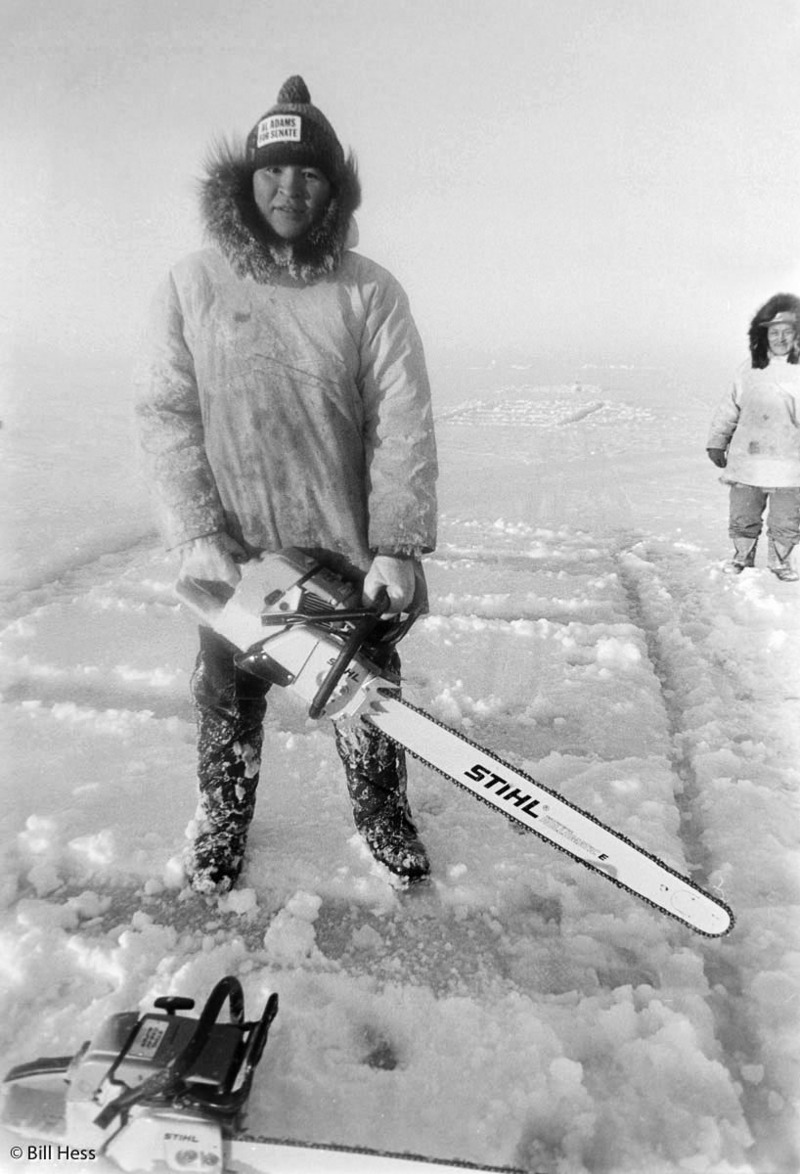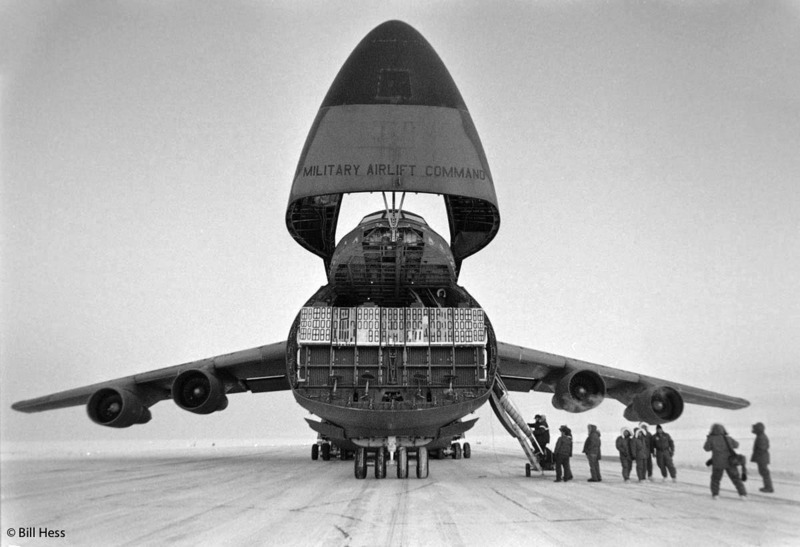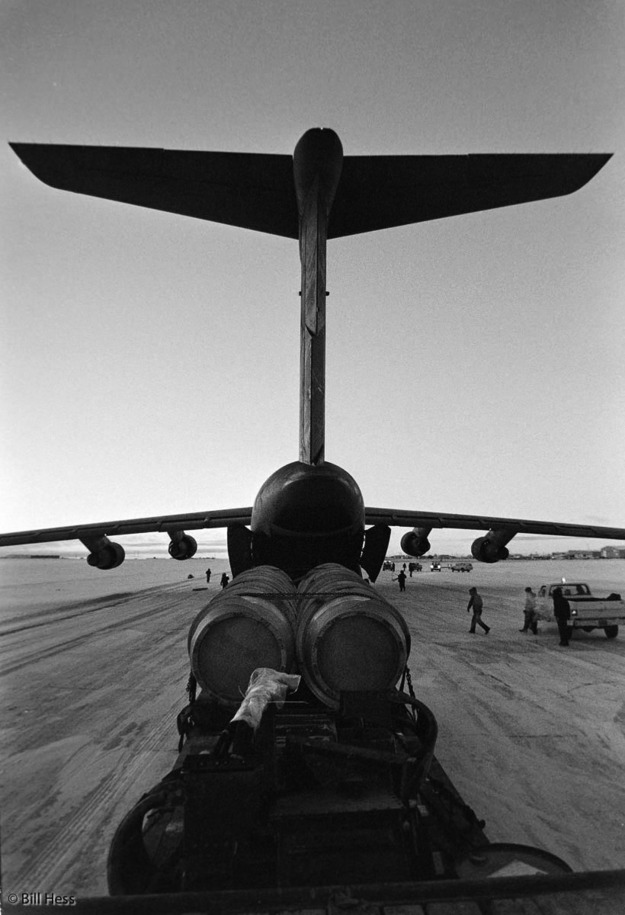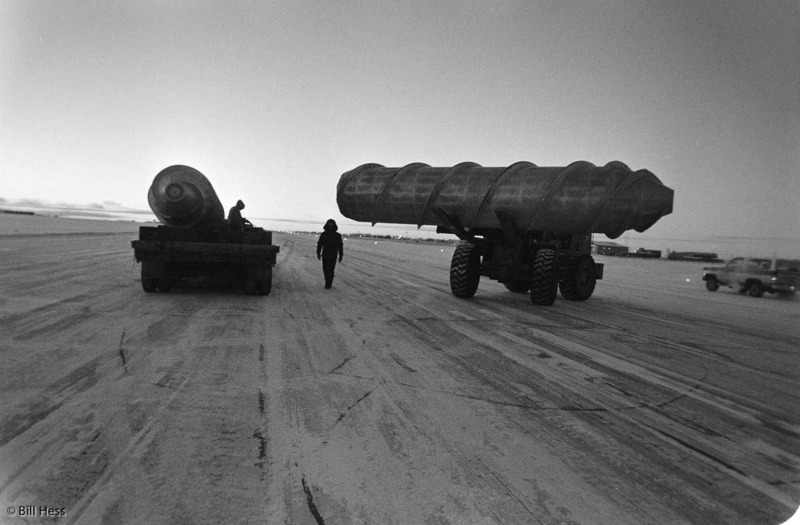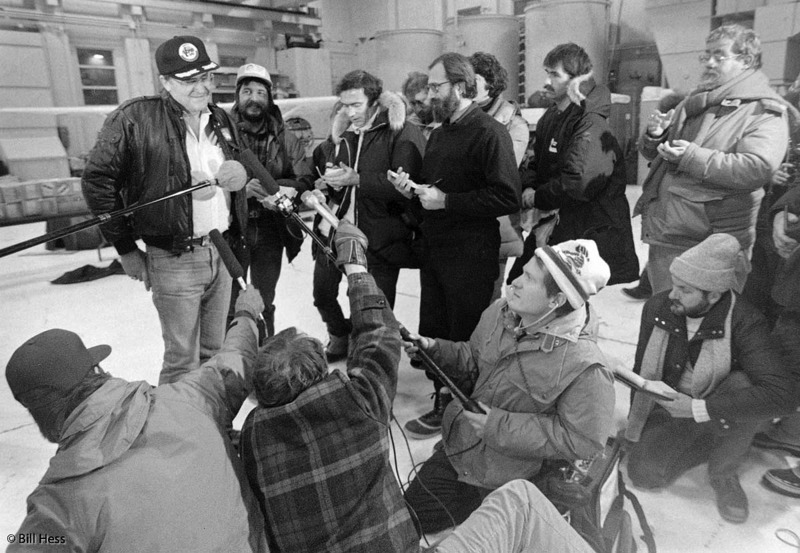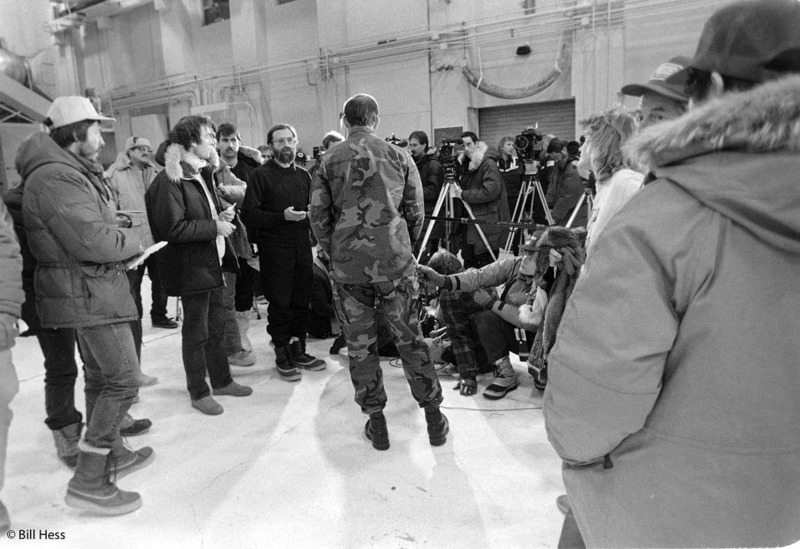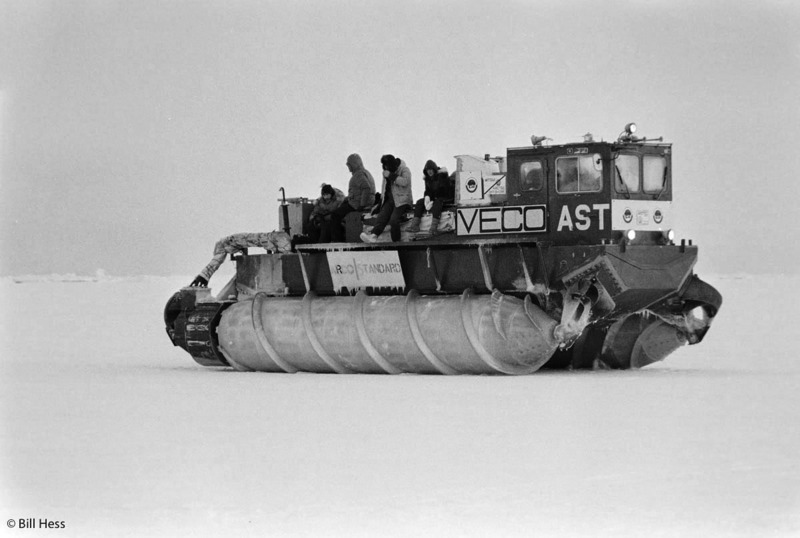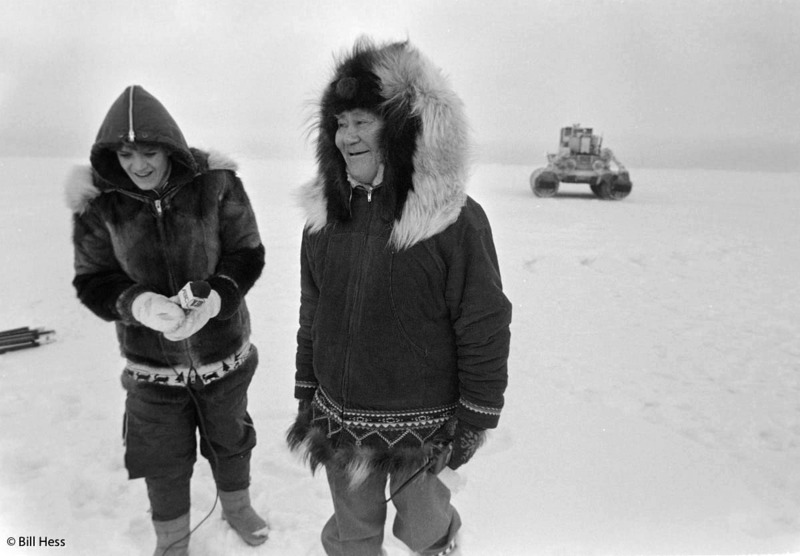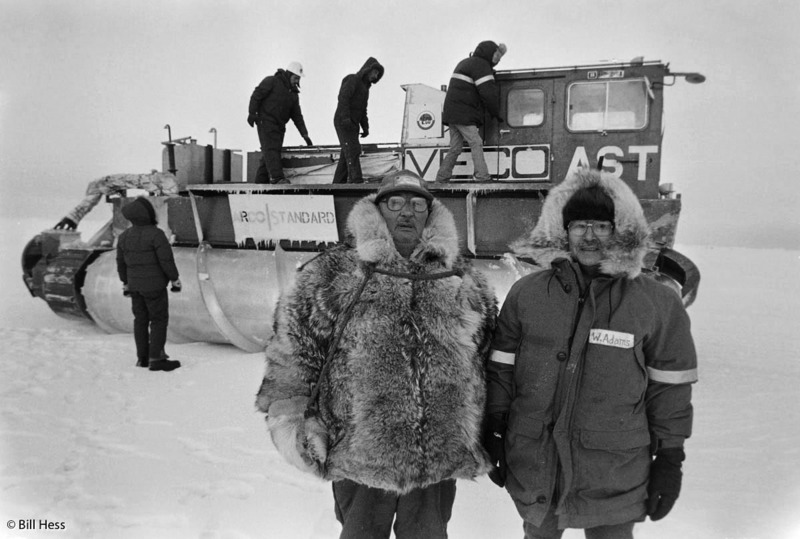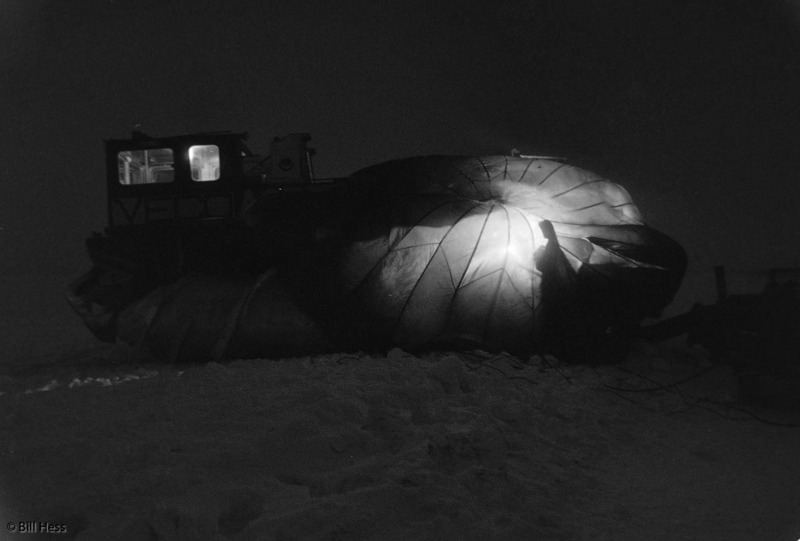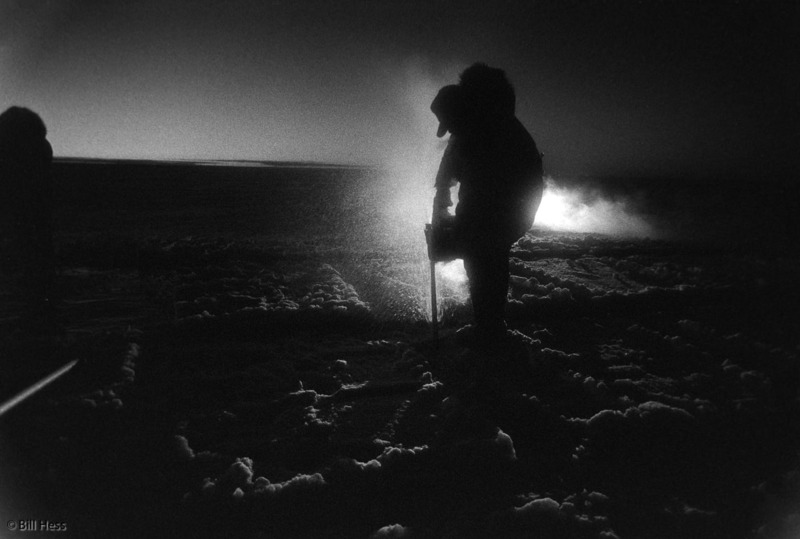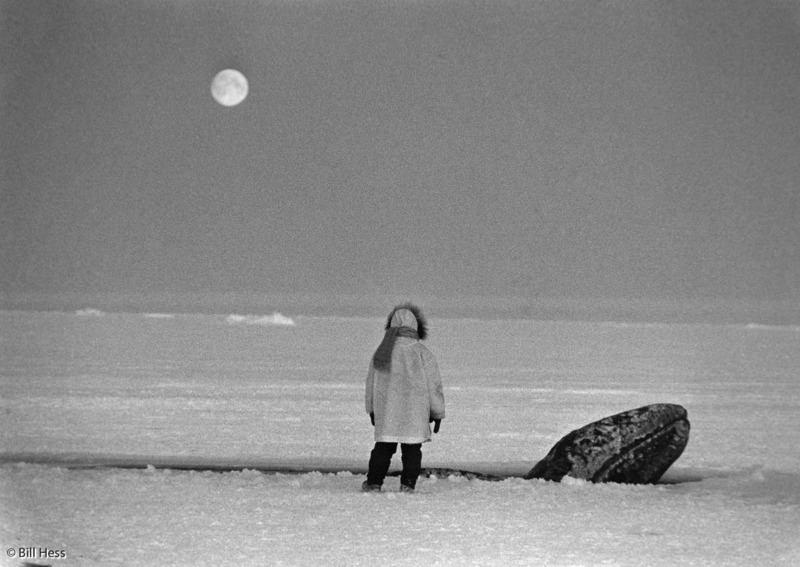
I apologize for the big gap between my last rescue post and this one. Right now, I am sitting in a small room in the White Mountain Apache Reservation home of my sister-in-law, LeeAnn, right next to a roaring fire that blazes in her pellet stove. The fire feels really good and I feel sleepy and lazy, which, if you knew what I have been through the past few days, including my sleepless red eye flight to Phoenix followed by my drive up here to the White Mountains, you would understand.
Anyway, back to the story:
Once the two surviving whales got moving, both they and the whalers on the chainsaw crew made good progress - especially after it was discovered the whales could be lured from hole to hole by the bubblers in the daytime and by lights at night.
Then, suddenly, the whales refused to go any further. The chainsaw holes had passed over a shoal where the water was only about 12 feet deep. From the viewpoint of a human, 12 feet of water seemed to be enough for the whales to swim through to the other side, but the whales did not seem to see it that way.
Thinking that perhaps it was that 12 feet seemed especially cramped in those stretches between holes when there would be ice above and ocean bottom below, the whalers and NSB biologists decided to cut one long hole that would reach from the deeper water on the shoreward side to the deeper water on the seaward side - a distance of about 250 feet. Come dark, they would also conduct a light experiment to try and draw the whales across.
In the late afternoon, everyone took a break. The media all but disappeared from the ice. Few people were left out here at all. One who did linger was veterinarian Cyd Hans, who would soon marry Craig George and would then produce one of the stars of the very first Barrow High School Whaler Football team in history.
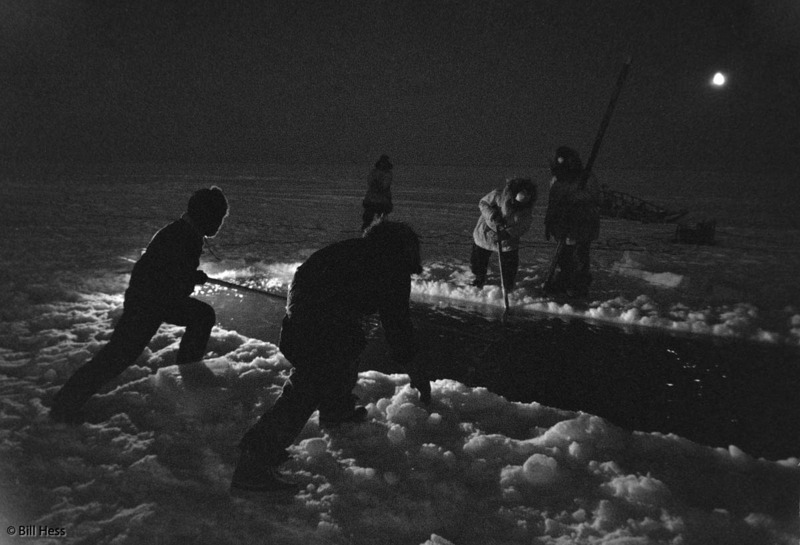
As darkness began to set in, the work started anew. Soon, it became too dark to take pictures - even when I pushed my T-Max 3200 ISO film to 6400, then 12,800. I decided that I might as well put my cameras up and wait until the light experiment began. It just might put out enough light that, if successful, I could photograph the whales as they followed the light all the way across the shoal. In the meantime, I decided to see if there was something I could do to assist the whalers and NSB wildlife biologists.
So I put camera in my camera bag, zipped it partially shut, and then placed it on the seat of my snowmachine. I would have zipped it all the way shut, but earlier in the day the zipper seam had torn part way and now would not close all the way. I then spotted Geoff nearby. He had placed a tall stand with a light atop it over the water at the shore-side end of the long hole. The whales were staying put in the holes over deeper water on the shore side.
The first job of a photographer is always to take pictures. In my early seasons at whale camp, those who I was with often did not understand this. If something was happening that required manual labor, they wanted "all hands" to join in that labor - if that hand was a photographer, then he had to put his camera down and join in. So, I had had to do so, just to keep my place in whaling camp. In the process, I had missed many a good picture, but over time still managed to get most key elements.
The pyschologiy that I should put my cameras down and help had set in, and so I made one of the biggest mistakes of my career and asked Geoff what I could do to help out.
He suggested that I take my snowmachine down to the far end of the hole and turn it so that it could sit there and idle with the light shining into the water. The story behind this snowmachine is a bit complicated and convoluted and it would take a lot of words to explain, but it make it short, it was brand new, it wasn't really mine but the Borough's and the Borough had assigned it to me, full time.
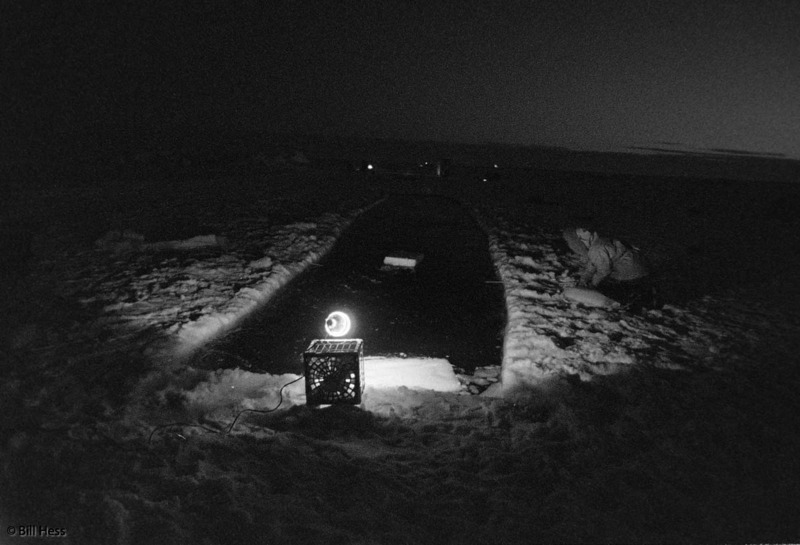
It was still in break-in mode. Sometimes, when I would give it a little gas to keep it idling, the throttle would stick and the snowmachine would lunge forward. I feared that if I pointed it right at the whale hole, this might happen. So, instead, I drove to the far end of the long whale hole and then parked it at an angle to the hole. I figured that whales could still see the light from this angle, but if the throttle should suddenly stick and the snowmachine lunge, it would scoot safely past the corner and stay on the ice.
So I parked, with my camera bag lying on the seat in front of me. I gently toyed with the throttle and brought it to idle, then put my left foot on the ice. As I swung my right leg over the seat to dismount, the machine started to die. I gave the throttle a quick, gentle, squeeze - then suddenly it stuck, the engine roared to full power and the snowmachine lunged forward faster and more violently than it ever had before.
It dumped me behind and then, just as in the contingency I had prepared for, it shot past the corner of the hole. What I had not envisioned is that it would be traveling with such speed that it would hit a nearby block of ice and then richochet right into the hole. Worse yet, my camera bag slid off into the water - right into the middle of the breadth of the hole. Thanks to the broken zipper, it started to sink, fast.
Rick Skluzacek of Minnesota was standing nearby. Qucikly, he dove to the edge of the hole, came down on his belly and grabbed the baggage bar at the rear of the machine. He expected me to grab on, too, but the machine was floating and my camera bag was sinking. I flung myself out over the hole so that my chest came down on the snownachine seat, plumnged my arm into the water and grabbed the camera bag, which had already sunk about a foot and was going down quick. I yanked it out of the water, flung it back onto the ice, then scooted backward and somehow managed to safely deposit myself onto the ice as well.
I then grabbed onto the luggar bar with Rick. Almost instantly, the engine and cowling sank completely and then the snow machine hung vertically like a dead fish. It was heavy, hard to support and we could not long grip the handle in these icy conditions. Someone grabbed a nearby shovel. We managed to slip it between the back bar and the seat and then to lay it across the corner so that it held the tail end of machine up and kept it from sinking altogether.
Arnold Brower Jr. then came along with a pickup truck, we roped the macine to the tow-hitch. It took two tries and one broken rope, but then Brower yanked the machine from the water. I think he was pretty irritated at me at that moment, because once the machine was out of the water he did not stop to discuss what we should do with it, but drove off straight for land.
Nothing will ruin a camera faster than a dunk in salt water. Thanks to the ripped zipper, the bag had completely filled with water. The zipped up side pouches, filled with film and accessories, had remained water tight and everything inside was dry. But when I opened up the bag, it was completely filled with slush which was quickly hardening into ice.
I dug the now ice-encased cameras out. It looked like I was out of action. My cameras were Canon F-1's, totally manual, set in a rugged case of brass. I thought it possible that the sea water had turned instantly to ice upon contact with the brass. If so, then maybe the ice itself had created a barrier that had kept the saltwater from reaching the inner workings of the cameras.
I caught a ride back to NARL. I sat down on the steel-latticed stairway, outside in the cold, took out my buck knife and carefully began to chip off the ice. Then at the end, I took a cloth and wiped off what was left. I then slowly warmed each camera in turn with my hands, then moved them into the Arctic entry, warmed them some more and finally took them inside.
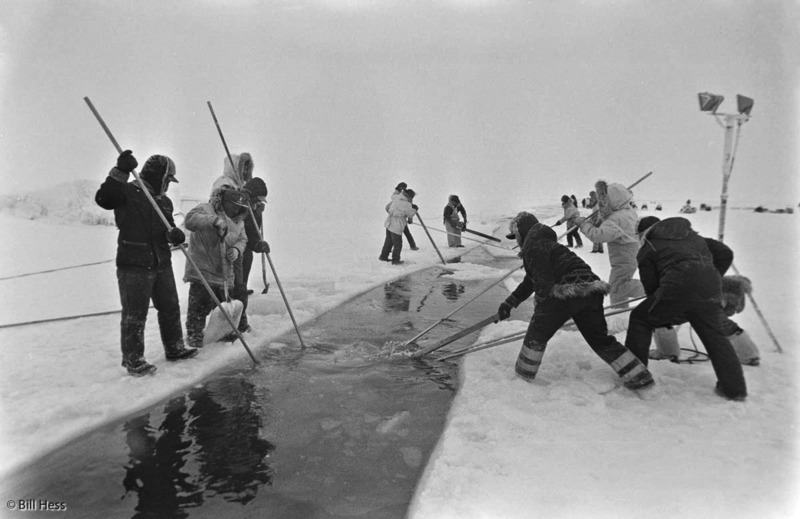
Guess what? They still worked. The tiny LCD on top that displayed shutter speed and apertuate information no longer worked, but I could manage without it.
So the next day I borrowed a snowmachine from NSB Wildlife and returned to the ice. I had missed the light experiment, which had failed to draw the whales over the shoal. Even so, the whales were now spending time in the big hole. To force them to stay there and not retreat back towards shore, the whalers and NSB biologists had opted to let the holes behind freeze over.
Furthermore, to force the whales to swim over the shoal, they had started to cut slabs of ice from the seaward side of the long hole and then float them to the shore side, to cover it, and freeze it over. Then, they hoped, the whales would have no choice but to advance over the shoal.
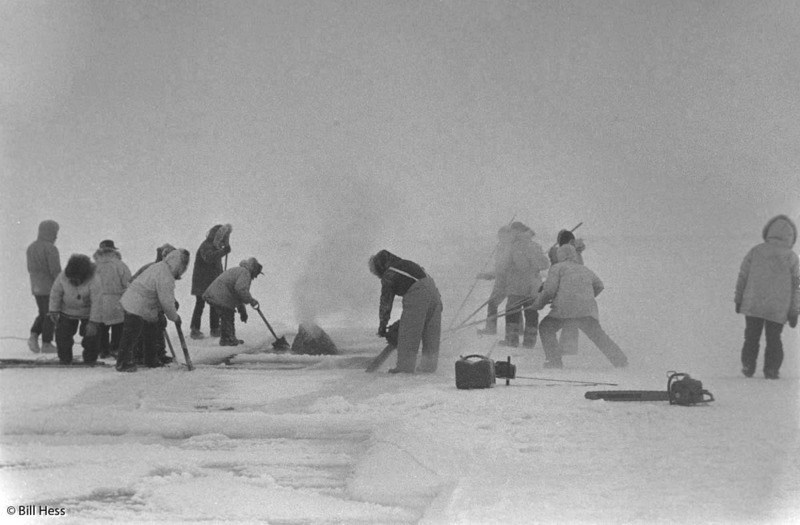
It didn't work. The whales kept swimming back into the slab covered, refreezing, ice. They pushed their snouts through slabs, chunks, and slush before it could completely freeze. They cut and scraped themselves. Their respiratory rates increased. They appeared more stressed. Sometimes, they rolled to their sides.
Here is a whale, rising into the newly covered shore end of the hole. That's Malik, with the shovel, closely studying the whale. Malik was always speaking to the whales, usually in Iñupiaq, encouraging them, trying to bolster their spirits. I am certain he was speaking to them here, as well.
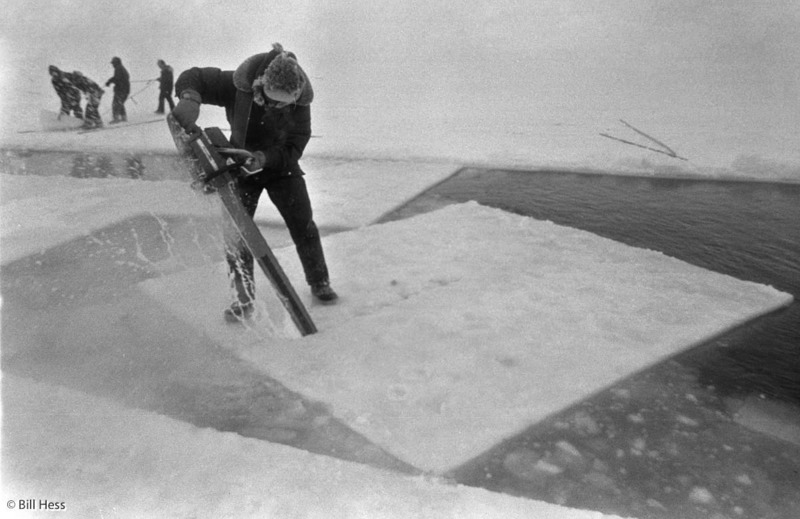
The whales needed a break. The effort to force them over the shoal was called off. Work began on a new hole, a hole wider in breadth than all the others, a hole the whales might use to calm down a bit, restore their normal breathing patterns, and get ready for the next step.
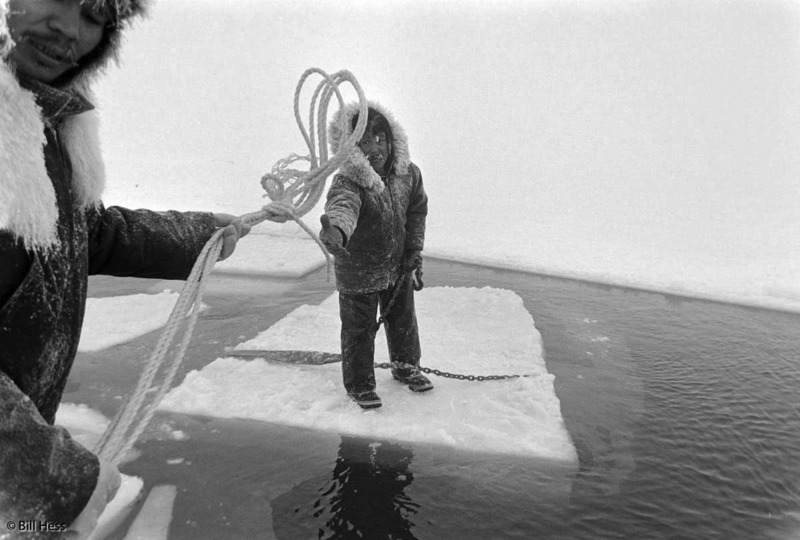
It struck me as dangerous work, this new hole. Whalers were floating around on slabs of ice, cutting them with chainsaws even as they did. Sometimes, a whaler needed a little assistance to get back to solid ice. Johnny Lee Aiken throws the rope of assistance.
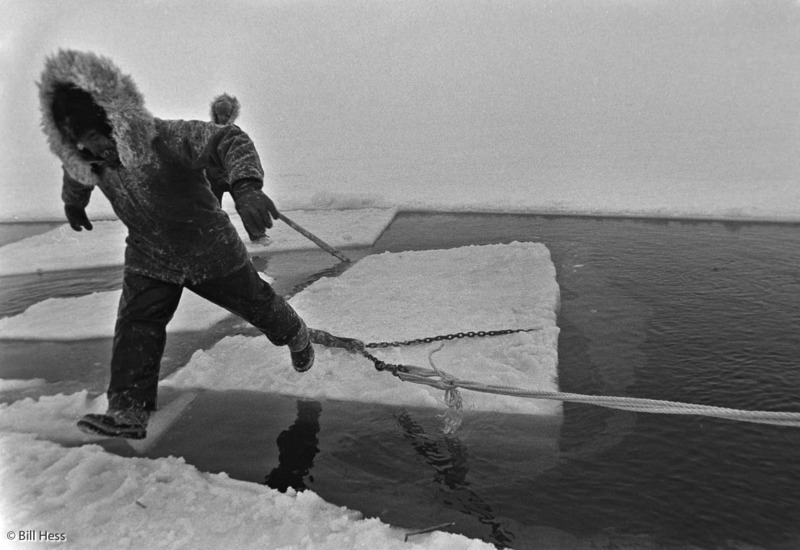
If you are ever in Barrow in a normal June (which, as the climate warms, is becoming less and less normal) you will see children playing on ice floes near shore - leaping from one to the other. It might frighten you to see a such a sight, because you will know that if the wrong thing happens it could be tragic -and sometimes, though rarely, has been - but it does help to prepare them for the kind of life an Iñupiat whaler leads.
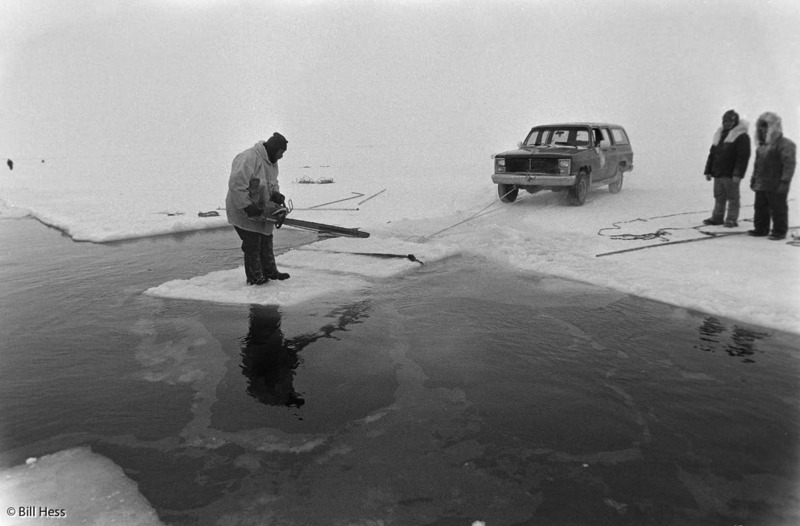
A bioiogist who grew up an easy train ride from New York City did not have that same kind of childhood experience, yet it is true that there are very few non-Iñupiat people who are as comfortable and competent on Arctic sea ice and water as Craig George and Geoff Carroll.
Still, Craig George was not prepared to have the slab of ice he was working on break in two prematiurely. Worse yet, the tiny, unstable piece that he stood on started to float to the middle of the hole, where he could easilly fall off and find himself pitched into a most troublesome and dangerous situation. I suspect that the whalers would have fished him out, but there would have been no guarantees.

Craig took a big leap...
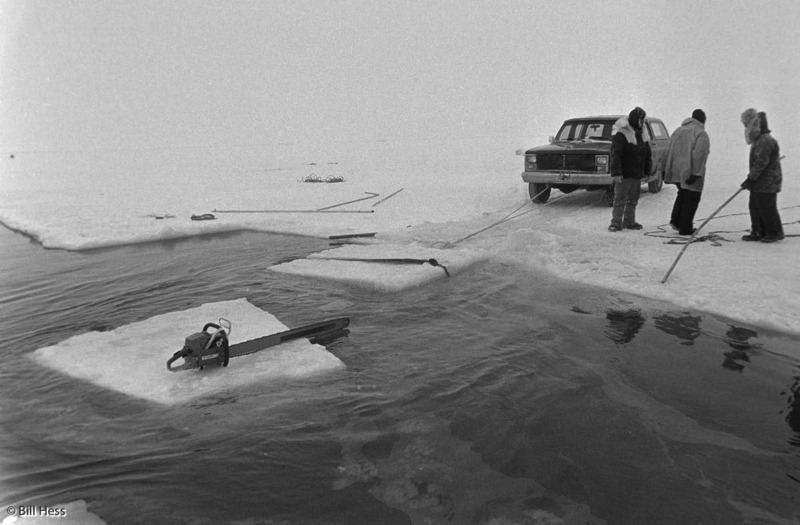
His chainsaw floated out into the hole - but it would be easy enough to retrieve.
"If you want to help the whales, you've got to think like a whale." I heard this statement attributed to two people - Malik and Arnold Brower, Sr. It is easy enough for me to believe that it expressed the thoughts of both.
So with Malik at the fore on the ice, they put their brains into whale mode and asked, what would a whale naturally do if came to shallow water over a shoal? The answer - swim around the shoal.
They decided then to begin a new series of holes, a series that would go, not over, but around the shoal.

Sure enough, the whales quickly took to this new series of holes as they were cut around the shoal The whales did not need lights to draw them, nor bubblers either. As soon as a new hole was cut, the two whales were in it. They seemed to understand what the holes were for. They seemed to know the holes were leading them to safe and open water. They seemed to grow ever more eager for each new hole to be cut.
In fact, they grew so eager that they quit waiting for the whalers to finish a hole. They began to pop up in the holes even as they were being cut. They wanted to get moving. Now, the whalers had to take care so as to not accidently cut a whale with a chainsaw.
That's what was happening here. Out in the ocean, two giant Soviet ice breakers - the equivalent of which the US lacked, were busting their way through the Arctic Ocean toward the whales. Those icebreakers, and a handful of the crew who manned and womaned them, will be the subject of my next post.
p>
Complete series index:
Part 1: Context bowhead hunt
Part 2: Roy finds the whales; Malik
Part 3: Scouting trip
Part 4: NBC on the ice
Part 5: To rescue or euthanize
Part 6: Governor Cowper, ice punch, chainsaw holes
Part 7: Malik provides caribou for dinner
Part 8: CNN learns home is sacred place
Part 9: World's largest jet; Screw Tractor
Part 10: Think like a whale
Part 11: Portrait: Billy Adams and Malik
Part 12: Onboard Soviet icebreakers
Part 13: Malik walks with whales, says goodbye
Part 14: Rescue concludes
Part 15: Epilogue
 Wednesday, February 22, 2012 at 12:37AM
Wednesday, February 22, 2012 at 12:37AM 

